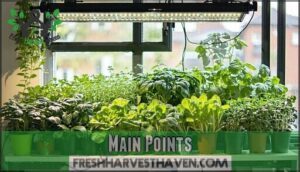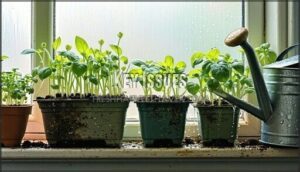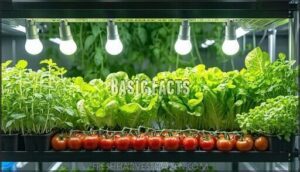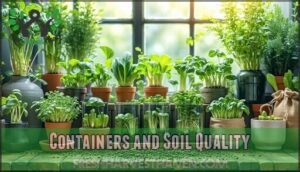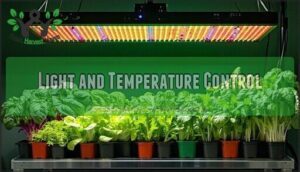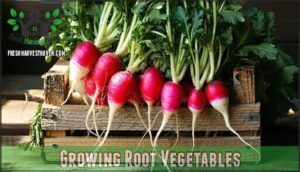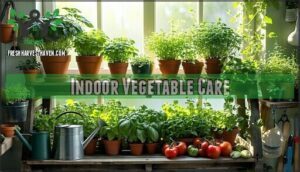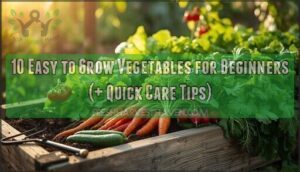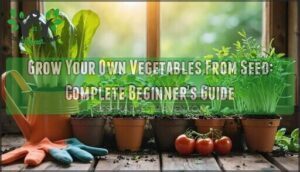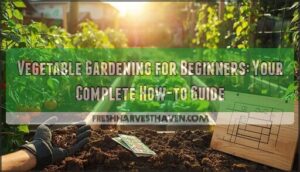This site is supported by our readers. We may earn a commission, at no cost to you, if you purchase through links.
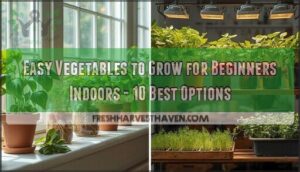
Leafy greens like lettuce and spinach thrive in containers and don’t need deep soil. Cherry tomatoes produce abundant harvests with basic grow lights. Herbs such as basil and cilantro grow quickly on windowsills.
Radishes mature in just 30 days, while carrots adapt well to deep pots. Scallions regrow from kitchen scraps, and microgreens sprout within a week.
These easy vegetables to grow for beginners indoors require minimal space and equipment. Success depends on understanding each plant’s specific lighting, watering, and spacing requirements for maximum yields.
Table Of Contents
- Key Takeaways
- Easy Indoor Vegetables
- Choosing Grow Lights
- Indoor Growing Tips
- Growing Root Vegetables
- Indoor Vegetable Care
- Frequently Asked Questions (FAQs)
- What is the easiest vegetable to grow indoors?
- What is the easiest vegetable to grow for a beginner?
- How to grow vegetables indoors all year round?
- What vegetables can you grow indoors?
- Can a beginner grow vegetables indoors?
- What plants can be grown indoors?
- What vegetables can you grow at home?
- What vegetables can be grown indoors without sunlight?
- What vegetables are good for a beginner garden?
- What is the easiest vegetable to grow for beginners?
- Conclusion
Key Takeaways
- You’ll succeed with leafy greens like lettuce and spinach since they need only 2-4 inches of soil depth and mature in 30-45 days with minimal care.
- Start with LED grow lights for consistent results – they provide full-spectrum lighting for 8-16 hours daily and consume less energy than other options.
- Choose proper containers with drainage holes and use quality potting mix instead of garden soil for better root health and moisture control.
- Monitor daily but don’t overwater – check soil moisture with your finger and maintain temperatures between 65-75°F for optimal growth.
Easy Indoor Vegetables
You’ll find that starting with easy-to-grow vegetables makes indoor gardening much less intimidating and far more rewarding.
Lettuce, herbs, and cherry tomatoes are perfect beginner choices since they don’t require complex care routines and you’ll see results quickly.
Start with easy wins—these three crops deliver fresh harvests without the fuss of complicated gardening routines.
Lettuce and Leafy Greens
Leafy varieties like romaine and buttercrunch lettuce make perfect beginner vegetables for indoor gardening. You’ll need containers just 2-4 inches deep with soil requirements that include well-draining potting mix.
Indoor lettuce thrives with 4-6 hours of indoor lighting daily, while watering needs stay moderate—keep soil moist but not soggy.
Leafy greens like spinach, kale, and arugula also flourish on windowsills with minimal pest control needed. These easy vegetables mature in 30-45 days, delivering fresh salads faster than you’d expect.
For ideal growth, understanding winter vegetable basics is essential to create a thriving indoor garden.
Cherry Tomatoes and Fruits
Success in cherry tomatoes starts with choosing compact varieties like ‘Tiny Tim’ or ‘Patio Princess’ for your indoor vegetable gardening setup.
These fruit selections thrive in containers with proper LED grow lights and consistent care, making growing vegetables indoors rewarding for beginners.
- Fruit Selection: Pick determinate cherry tomatoes that stay small and produce heavy yields
- Container Requirements: Use 5-gallon pots with drainage holes for healthy root development
- Light Needs: Provide 8+ hours of bright LED grow lights for ideal fruit production
- Support Systems: Install small cages or stakes early to support heavy fruit clusters
- Fruit Harvesting: Pick tomatoes when fully colored but still firm for best flavor
Herbs and Microgreens
After growing sweet cherry tomatoes, you’ll find herbs and microgreens equally rewarding for beginner vegetables.
These plants deliver fresh flavors with minimal effort:
- Basil Care: Plant seeds in small pots, harvest leaves regularly for continuous growth
- Green Onions: Regrow from kitchen scraps in water, then transplant to soil
- Indoor Sprouts: Ready in just 7-14 days with basic containers and shallow soil
- Microgreen Harvest: Cut above soil level when 1-2 inches tall for maximum nutrition
- Herb Planting: Start oregano and cilantro from seeds in well-draining potting mix
Growing indoors becomes simple when you focus on these easy vegetables that thrive in containers with basic care.
Choosing Grow Lights
You’ll need proper grow lights if your windows don’t provide enough natural sunlight for healthy plant growth.
LED grow lights offer the best combination of energy efficiency and full-spectrum light that mimics sunlight, making them ideal for beginners who want reliable results without high electricity bills, with reliable results being a key benefit.
Main Points
Your indoor gardening success depends on matching grow lights to your vegetable selection. LED full-spectrum lights excel for beginner vegetables while consuming less energy.
You’ll want fluorescent T5s for leafy greens and herbs in your windowsill garden. Compact fluorescents work perfectly for small spaces and easy vegetables.
Metal halide and high-pressure sodium lights suit advanced growers with fruiting plants. Understanding these growing conditions helps you create the perfect urban farming setup for growing indoors year-round.
When selecting lighting, consider using LED grow lights for ideal results.
Light Type Best For Energy Use
easy vegetables to grow indoors
beginner vegetables
Key Issues
Challenges plague beginners tackling growing vegetables indoors. Space management limits variety choices, while poor soil quality stunts growth.
Water requirements vary dramatically between plants, creating confusion. Nutrient deficiency strikes fast in containers, and pest control becomes complex without natural predators helping your indoor vegetable gardening efforts.
Insufficient light can lead to leggy seedling growth.
Basic Facts
LED grow lights typically deliver superior results for indoor vegetable gardening. These energy-efficient lights run 12-16 hours daily, providing essential growing conditions for beginner gardening success.
Red spectrum promotes flowering in tomatoes and peppers, while blue strengthens indoor salad greens. Full-spectrum LEDs work best for easy crops like lettuce and herbs.
Consider specific LED products for maximum growth. Position lights 6-12 inches above plants, adjusting as they grow.
Proper illumination guarantees your vegetable types thrive indoors with consistent yields.
Indoor Growing Tips
You’ll need the right setup to transform your indoor space into a productive vegetable garden.
Success depends on three key factors: proper containers with drainage, quality potting mix, adequate lighting, controlled temperature, and a consistent watering and fertilization routine.
Containers and Soil Quality
Your container and soil choices make or break your indoor gardening success. Think of containers as your plants’ foundation – they need proper drainage holes and adequate depth to thrive.
Here’s what you’ll need for container gardening success:
- Select containers with multiple drainage holes and appropriate container size for each plant type
- Choose quality potting mixes instead of heavy garden soil for better aeration and drainage
- Test soil nutrients and maintain pH between 6.0-7.0 for ideal growth
- Consider fabric pots for superior root health and natural moisture regulation
- Ensure proper potting soil depth – at least 6 inches for leafy greens, 12+ inches for fruiting plants
Quality potting soil prevents waterlogged roots and supports healthy indoor gardening ventures. Consider that drainage holes are essential for perfect plant health.
Light and Temperature Control
Throughout every season, your indoor vegetables depend on precise light spectrum and temperature control to thrive.
Most easy vegetables need consistent temperatures between 65-75°F, while their light requirements vary dramatically by plant type.
Grow lights become your secret weapon for year-round success.
LED options offer the best energy efficiency and optimal placement flexibility.
Position full-spectrum lights 6-16 inches above leafy greens, while fruiting plants like tomatoes need closer placement at 8-12 inches for maximum photosynthesis.
Here’s your quick reference guide:
Seasonal adjustments matter too—raise lights slightly during summer months to prevent overheating.
Monitor your plants’ response and adjust accordingly for indoor gardening success.
Watering and Fertilization
Your plants’ health depends on proper watering frequency and nutrient balance.
Check soil moisture by inserting your finger one inch deep—water when it feels dry. Maintain consistent watering without overdoing it, as waterlogged roots invite trouble.
Apply water-soluble fertilizer types every two weeks to prevent nutrient deficiencies. Monitor soil pH levels between 6.0-7.0 for maximum nutrient uptake.
In hydroponics systems, pH control becomes even more critical. This balanced approach to watering and fertilization guarantees your indoor gardening success.
Growing Root Vegetables
You’ll find root vegetables surprisingly rewarding since they adapt well to containers and don’t need perfect growing conditions.
Radishes mature in just 3-5 weeks, making them perfect confidence builders for new indoor gardeners, and they can be considered perfect examples.
Carrots and Beets
Carrots and beets thrive in indoor gardens when you get the basics right. These root vegetables need specific conditions but reward you with fresh, homegrown produce year-round.
- Container Size and Soil Depth: Use containers at least 12 inches deep with loose, sandy potting mix for proper root development and ideal pH around 6.0-7.0.
- Indoor Varieties: Choose compact carrots like Thumbelina or Nantes and smaller beet varieties like Detroit Dark Red for container gardening success.
- Germination Rates: Keep soil consistently moist and provide 6+ hours of bright light daily to achieve strong germination rates and healthy growth. You can easily find indoor carrot seeds for your indoor garden.
Potatoes and Sweet Potatoes
Growing potatoes indoors feels like uncovering buried treasure right in your kitchen.
Start with seed potato varieties like Fingerling or Red Pontiac in deep containers holding 2.5+ gallons. Sweet potato types begin as slips—sprouted shoots from store-bought tubers submerged in water.
Both need 8-10 hours of light daily and consistently moist soil. Regular "hilling up" soil around potato stems boosts yields substantially.
To avoid issues, use certified disease-free seed potatoes. Harvesting tips: dig when foliage yellows after 3-4 months of patient indoor gardening.
Radishes and Turnips
Beyond their crisp appeal, radishes and turnips offer fantastic easy vegetables for indoor gardening.
Various radish varieties like Cherry Belle mature in just three weeks, while turnip nutrition makes them worthwhile additions.
Master planting techniques using loose soil and proper spacing. Simple pest control keeps plants healthy indoors.
Harvesting tips include pulling when roots reach marble size. Both indoor radishes and turnips thrive in containers, making vegetable gardening accessible for beginners seeking quick, satisfying results.
Indoor Vegetable Care
Once you’ve got your indoor vegetables growing, regular monitoring keeps them healthy and productive.
Check soil moisture daily, watch for pest issues, and provide consistent care to guarantee your plants thrive from seedling to harvest, ensuring they receive the necessary attention to be productive.
Monitoring and Maintenance
Your indoor garden’s success hinges on consistent monitoring and maintenance routines. Establish weekly check-ins to assess soil moisture levels using your finger or a moisture meter—overwatering kills more plants than drought.
Smart indoor gardeners know that consistent daily checks prevent more problems than any fancy equipment ever could.
Daily leaf health inspections catch early warning signs like yellowing, curling, or brown spots that signal nutrient deficiencies or pest invasions.
Essential monitoring tasks include:
- Weekly soil moisture checks prevent root rot and guarantee proper watering schedules
- Daily leaf inspections reveal pest control needs and air circulation problems
- Regular pollination assistance for fruiting plants maximizes your harvest potential
Indoor gardening requires attention to light requirements, especially during shorter winter days. Watch for leggy growth or pale leaves indicating insufficient lighting.
Proper air circulation prevents fungal issues while supporting healthy plant transpiration. Small investments in monitoring tools pay dividends in healthier, more productive plants.
Common Challenges and Solutions
Even with careful planning, indoor gardening throws curveballs your way.
Pest control issues like aphids affect 45% of setups, while nutrient deficiencies from over-fertilizing cause leggy growth in 25% of cases. Light requirements aren’t met in 75% of failures, and drainage problems lead to root rot in 60% of gardens.
Addressing these challenges often requires supplemental lighting, as insufficient natural light can substantially hinder plant growth.
Challenge Solution Tip
Harvesting and Storage Techniques
Perfect timing makes the difference between wilted disappointment and crisp satisfaction. Harvest timing directly impacts flavor and shelf-life for your indoor vegetable varieties.
Proper storage begins before you even pick your first leaf. Here’s your post-harvest handling roadmap:
- Harvest during morning hours when plants are fully hydrated—use clean, sharp scissors to cut greens 1 inch above the base for regrowth
- Skip washing root vegetables immediately; instead, brush off soil gently and trim tops to prevent moisture loss during storage
- Store leafy greens in the fridge at 34-38°F with high humidity, while root vegetables prefer cool, dark spaces for extending shelf-life
Smart harvesting and storage techniques transform your indoor gardening efforts into weeks of fresh produce. Remember: damaged vegetables spoil faster, so use those first. To extend shelf life, consider that humidity levels matter.
Tips for Success and Troubleshooting
Smart pest control starts with pest identification—watch for aphids on leafy greens and spider mites on tomatoes.
Nutrient deficiencies show as yellow leaves, so adjust feeding schedules accordingly.
Pollination issues plague fruiting plants, so hand-pollinate with cotton swabs.
Mold prevention requires proper airflow and spacing.
Monitor root health by checking drainage regularly.
| Problem | Quick Fix |
|---|---|
| Yellowing leaves | Check nitrogen levels and adjust fertilizer |
| Poor fruit set | Hand-pollinate flowers with small brush |
| Fungal growth | Increase air circulation, reduce watering |
| Stunted growth | Verify adequate light and container size |
| Pest infestation | Use neem oil or insecticidal soap treatment |
These indoor vegetable gardening troubleshooting steps work for most beginner gardening challenges.
Frequently Asked Questions (FAQs)
What is the easiest vegetable to grow indoors?
Like a child taking their first baby steps, radishes sprint from seed to harvest in just 3-4 weeks.
You’ll find these crimson gems require minimal fuss—just 4-6 hours of light daily and loose soil in any container.
What is the easiest vegetable to grow for a beginner?
Lettuce tops the beginner-friendly list since it thrives in containers with just four hours of sunlight daily. You’ll harvest crisp leaves in 30-45 days without fuss.
How to grow vegetables indoors all year round?
Like Goldilocks finding the perfect porridge, you’ll discover year-round indoor growing needs consistent LED lights, quality potting mix, proper drainage, and temperature control between 65-75°F for continuous harvests.
What vegetables can you grow indoors?
You can grow leafy greens like lettuce, spinach, and kale indoors year-round.
Herbs such as basil and thyme thrive inside.
Root vegetables like radishes and carrots work well in deep containers.
Can a beginner grow vegetables indoors?
Sixty-seven percent of indoor gardeners successfully harvest their first crop within two months.
You’ll thrive with beginner-friendly vegetables like lettuce, spinach, radishes, and microgreens that need basic containers and minimal care, allowing for a successful harvest with minimal effort.
What plants can be grown indoors?
You can successfully grow leafy greens like lettuce and spinach, quick herbs like basil, fast radishes, microgreens, and compact tomatoes indoors with proper containers, soil, and lighting.
What vegetables can you grow at home?
You’ll transform your kitchen into a green sanctuary where humble seeds become nutrient-packed treasures.
Fast-growing options like lettuce, spinach, kale, radishes, and herbs thrive indoors with proper containers and lighting conditions, making them ideal for an indoor garden to produce nutrient-packed treasures.
What vegetables can be grown indoors without sunlight?
You’ll need LED grow lights since most vegetables require artificial lighting indoors without natural sunlight. Leafy greens like lettuce, spinach, and kale thrive under grow lights with proper containers.
What vegetables are good for a beginner garden?
Like planting seeds of confidence, you’ll find lettuce, radishes, and spinach are your garden’s gateway crops. These forgiving vegetables thrive indoors with minimal fuss and reward you with quick harvests.
What is the easiest vegetable to grow for beginners?
Radishes are your best bet for guaranteed success. They’ll sprout within days and reach harvest size in just three to five weeks, making them practically foolproof for new gardeners.
Conclusion
Starting your indoor gardening journey is like having a green thumb in your back pocket – you’ll discover these easy vegetables to grow for beginners indoors transform any space into a productive mini-farm.
You’ve learned that lettuce, tomatoes, herbs, and root vegetables all thrive with proper lighting and care.
With consistent watering, quality soil, and attention to each plant’s needs, you’ll enjoy fresh harvests year-round, and your success grows with practice and patience.
- https://www.allrecipes.com/article/growing-vegetables-indoors/
- https://www.azurefarmlife.com/farm-blog/the-best-vegetable-to-grow-indoors
- https://bonnieplants.com/blogs/garden-fundamentals/indoor-vegetable-gardening
- https://gardenbetty.com/indoor-vegetables/
- https://www.thespruce.com/how-to-grow-vegetables-indoors-1403183

